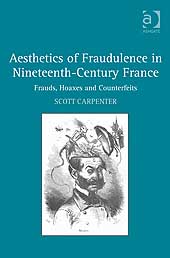
Scott Carpenter
Aesthetics of Fraudulence in Nineteenth-Century France: Frauds, Hoaxes, and Counterfeits,
Farnham: Ashgate Publishing, 2009, 204 p.
- isbn 13 (ean): 9780754668077
Extraits à télécharger:
Focusing particularly on the aesthetics of fraudulence in works by Mérimée, Balzac, Baudelaire, Vidocq, Sand, and others, Scott Carpenter analyzes manifestations of the false in nineteenth-century French literature. Placing literary representations within the context of cultural phenomena such as caricature, political history, and ceremonial events, Carpenter argues that the problem of fraudulence involves a blurring of limits between hitherto discrete categories, challenging Romantic notions of authenticity and sincerity.
In his engagingly written and original book, Scott Carpenteranalyzes multiple manifestations of the false in nineteenth-centuryFrance. Under Carpenter's thorough and systematic analysis, fraudulenceemerges as a cultural preoccupation in nineteenth-century literatureand society, whether it be in the form of literary mystifications, thethematic portrayal of frauds, or the privileging of falseness as anaesthetic principle. Focusing particularly on the aesthetics offraudulence in works by Mérimée, Balzac, Baudelaire, Vidocq, Sand, andothers, Carpenter places these literary representations within thecontext of other cultural phenomena, such as caricature, politicalhistory, and ceremonial events. As he highlights the specialrelationship between literary fiction and fraudulence, Carpenter arguesthat falseness arises as an aesthetic preoccupation inpost-revolutionary France, where it introduces a blurring of limitsbetween hitherto discrete categories. This transgression of boundarieschallenges notions of authenticity and sincerity, categories thatRomantic aesthetics championed at the beginning of the nineteenthcentury in France. Carpenter's study makes an important contribution tothe cultural significance of mystification in nineteenth-century Franceand furthers our understanding of French literature and culturalhistory.
-
Contents: Introduction: caveat lector; Violenthoaxes: Mérimée and the booby-trapped text; Political prostheses andimperial imposters; The ghosts of kings; Balzac''s skillful disguise;Vidocq and the image of the counterfeit; False genders: Sand''sGabriel; Baudelaire and the originality of the copy; National effigiesand counterfeits: Baudelaire''s Pauvre Belgique!; Conclusions: futuresof the false; Bibliography; Index.
-
About the Author: Scott Carpenter is aProfessor of French at Carleton College (Minnesota). His other worksinclude Acts of Fiction: Resistance and Resolution from Sade toBaudelaire (1996) and Reading Lessons: An Introduction to Theory (2000).
-
Reviews: 'Scott Carpenter takes his readersfor a ride: under the guise of a lively and witty excursion throughnineteenth-century literary frauds and hoaxes, he provides rich andsubtle readings of political caricatures and texts by Mérimée, Balzac,Sand, Vidocq, and Baudelaire (his analyses of Baudelaire's prose poemsare especially penetrating). Along the way, he explores issues in thenature and aesthetics of mystification that are at the heart of theliterary enterprise itself.'
Carol Rifelj, Middlebury College, USA -
This title is also available as an eBook, ISBN 978-0-7546-9631-5